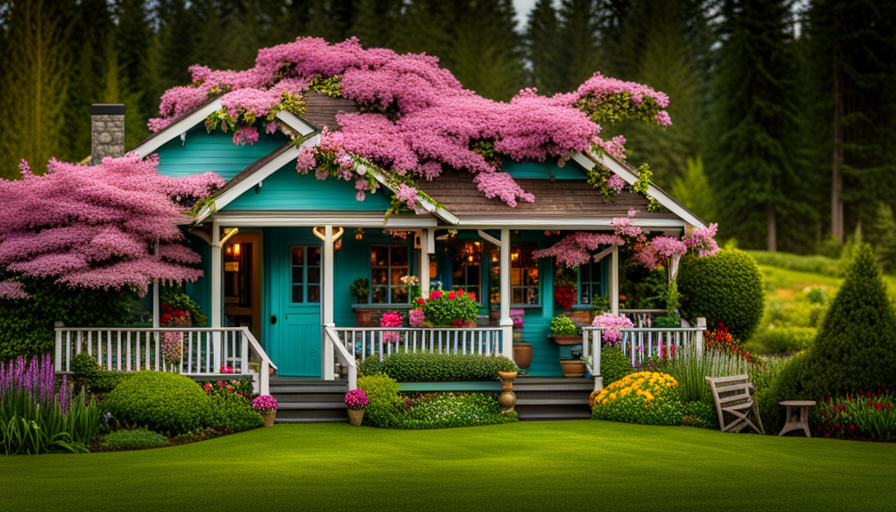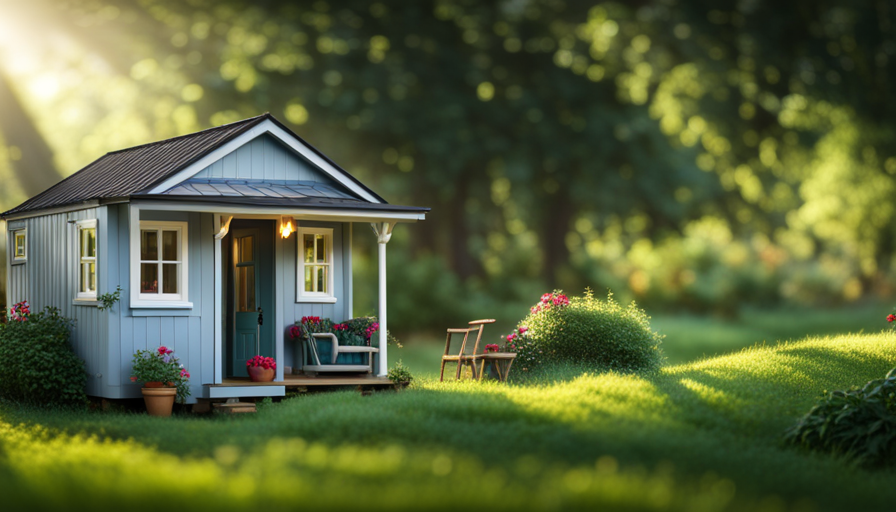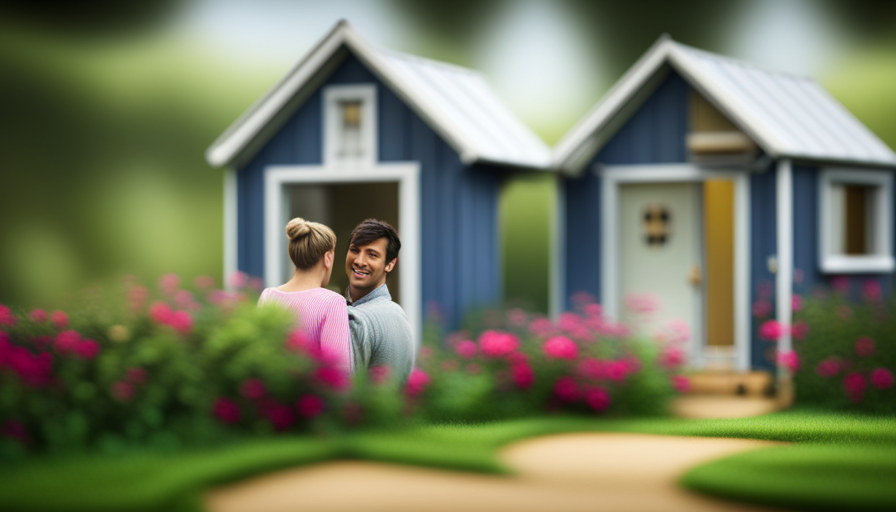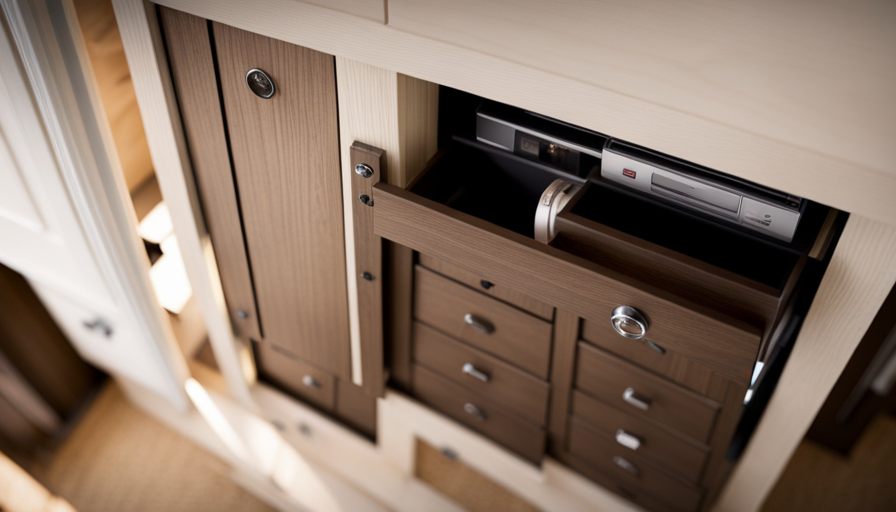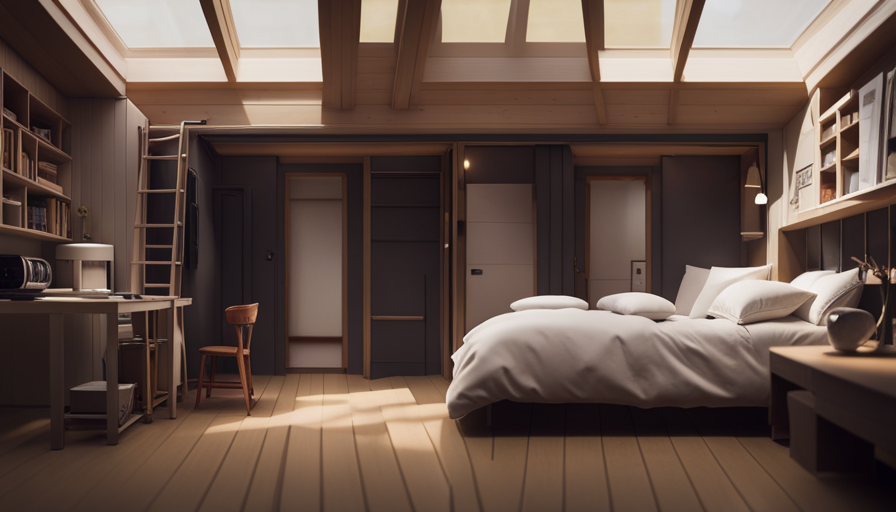As I stand in the lush surroundings of Oregon, surrounded by tall trees and beautiful views, I can’t help but wonder: what is considered a small house in this scenic state?
Like a hummingbird among giants, these pint-sized dwellings have become a popular choice for those seeking a simpler, more sustainable way of life. In Oregon, the definition of a tiny house is a dwelling that measures 400 square feet or less, allowing for creative and efficient use of space. But it’s not just about size; it’s about a mindset.
Living in a tiny house means embracing minimalism, reducing our carbon footprint, and finding freedom in simplicity. In this article, we will delve into the regulations, benefits, design possibilities, and challenges of tiny house living in Oregon.
So, join me on this journey as we explore the world of tiny homes in the great state of Oregon.
Key Takeaways
- The definition of a tiny house in Oregon is 400 square feet or less.
- Tiny houses in Oregon offer benefits such as minimalism, reduced carbon footprint, and simplicity.
- Tiny houses in Oregon are often built on wheels, providing mobility and flexibility.
- There are regulations and size limitations in Oregon for the construction and placement of tiny houses, including restrictions on height and width in some cities.
Understanding the Definition of a Tiny House
Imagine a cozy little dwelling tucked away in the picturesque landscapes of Oregon, where a tiny house is defined as a charming, compact home measuring less than 400 square feet. The defining criteria for a tiny house in Oregon are based on its size, not its architectural style or materials used. These homes are often built on wheels, allowing for mobility and flexibility.
However, it’s important to address the misconceptions and stereotypes associated with tiny houses. Contrary to popular belief, tiny houses aren’t just glorified sheds or temporary structures. They can be fully functional homes, complete with all the necessary amenities and features. Understanding these defining criteria and debunking misconceptions helps to paint a clearer picture of what a tiny house truly is.
Now, let’s explore the regulations and size limitations in Oregon.
Regulations and Size Limitations in Oregon
Explore the restrictions and dimensions within Oregon’s regulations, and discover how the size of your dwelling can either limit or liberate your dreams.
In Oregon, there are specific regulations and size limitations that govern the construction and placement of tiny houses. These regulations are in place to ensure the safety and well-being of occupants, as well as to maintain the aesthetic appeal of neighborhoods. Here are some key points to consider:
- The maximum size of a tiny house on wheels is usually around 400 square feet.
- Some cities in Oregon have additional restrictions on the height and width of tiny houses.
- Tiny houses on foundations are subject to local building codes, which may require a minimum square footage.
- Zoning laws vary across different areas in Oregon, so it’s important to check the specific regulations for the location where you plan to build or park your tiny house.
- It’s advisable to consult with local authorities and professionals to ensure compliance with all regulations.
Understanding these regulations and size limitations will play a crucial role in determining the feasibility of your tiny house project. With this knowledge, you can move forward and explore the benefits of living in a tiny house.
Benefits of Living in a Tiny House
Discover the freedom and simplicity of embracing a minimalist lifestyle in a compact, cozy dwelling. Living in a tiny house in Oregon comes with numerous benefits, including financial considerations and a reduced environmental impact. By opting for a tiny house, you can significantly lower your expenses. With smaller square footage, utility bills and maintenance costs are greatly decreased. Additionally, the reduced environmental impact of a tiny house is noteworthy. These homes require fewer resources to build and maintain, resulting in a smaller carbon footprint. Living in a tiny house allows you to minimize your ecological impact and be more environmentally conscious. In the next section, we will explore how you can design and customize your tiny house in Oregon to suit your unique preferences and needs. Let’s dive into the exciting world of creating your perfect tiny oasis.
Designing and Customizing Your Tiny House in Oregon
Get ready to unleash your creativity and transform your compact haven into a personalized masterpiece that reflects your unique style and needs.
When designing and customizing your tiny house in Oregon, there are a few tips to keep in mind. First, maximize your space by utilizing multi-functional furniture and storage solutions. Think about incorporating built-in shelves, hidden compartments, and lofted areas for additional living space.
Next, consider the cost considerations of your design choices. While it may be tempting to splurge on high-end finishes, remember that every dollar adds up in a tiny house. Prioritize your must-haves and be mindful of your budget.
Finally, think about how your design will complement the surrounding landscape and adhere to local building codes. With these designing tips and cost considerations in mind, you can create a stunning and functional tiny house that is uniquely yours.
So, now that you have your design plan in place, let’s explore finding land and parking options for your tiny house.
Finding Land and Parking Options for Your Tiny House
When it comes to finding land and parking options for my tiny house, there are a few key points to consider.
First, I need to understand the zoning and land use regulations in the area I plan to live in. This will determine whether I can legally park my tiny house on a piece of land or not.
Additionally, I can explore the option of living in tiny house communities, which are specifically designed for tiny homes and often provide utilities and amenities.
Another option is to park my tiny house in RV parks, which may have specific regulations and requirements for tiny house owners.
Overall, it’s important to research and understand the different options available for parking your tiny house to ensure a smooth and legal living experience.
Zoning and Land Use Regulations
Although zoning and land use regulations vary across Oregon, it’s important to understand the dimensions that classify a tiny house as small enough to comply with local guidelines. Here are three key considerations when it comes to zoning challenges and building codes for tiny houses in Oregon:
-
Minimum square footage: Many cities and counties in Oregon have established minimum square footage requirements for dwellings. These requirements often exceed the size of a typical tiny house, which can range from 100 to 400 square feet.
-
Building permits: Before constructing a tiny house, you’ll need to obtain the necessary building permits. These permits ensure that your tiny house meets safety standards and complies with local building codes.
-
Zoning restrictions: Zoning regulations can dictate where you can legally park and live in a tiny house. Some areas may allow tiny houses as accessory dwelling units, while others may require them to be located in designated tiny house communities or RV parks.
Understanding these aspects of zoning and building codes is crucial when navigating the regulations for tiny houses in Oregon. Moving forward, let’s explore the options available for tiny house communities and RV parks.
[Transition sentence into next section: Now that we have a better understanding of zoning and land use regulations, let’s explore the opportunities for tiny house communities and RV parks.]Tiny House Communities and RV Parks
Imagine stepping into a world where community and freedom intertwine, where like-minded individuals gather in picturesque settings to create their own tiny havens. In Oregon, tiny house communities and RV parks provide the perfect backdrop for those seeking a minimalist lifestyle.
These communities offer a range of amenities and shared spaces, fostering a sense of belonging and connection. Additionally, financing options are available for those looking to purchase or build their own tiny house, making it an accessible dream for many.
One of the advantages of tiny houses is their eco-friendly features, such as solar panels and composting toilets, which promote sustainable living.
As we delve into the challenges and considerations for tiny house living in Oregon, it is important to remember the sense of community and environmental consciousness that these communities foster.
Challenges and Considerations for Tiny House Living in Oregon
Living in a tiny house in Oregon presents a unique set of challenges and considerations. First and foremost, limited space requires lifestyle adjustments to downsize and simplify.
Additionally, many tiny house owners in Oregon choose to live off-grid, which entails finding alternative sources for utilities such as water and electricity.
Overall, tiny house living in Oregon requires careful planning and adaptation to make the most of the limited space and embrace a more sustainable lifestyle.
Limited Space and Lifestyle Adjustments
When you live in a tiny house in Oregon, you’ll quickly discover the need to adjust your lifestyle to fit within the limited space. The challenges of limited space are a constant reality, requiring a minimalist mindset and creative solutions.
Downsizing your belongings is essential, as every item must serve a purpose or have multiple uses. Storage solutions such as built-in cabinets, foldable furniture, and vertical shelving are crucial to maximize the available space.
Adapting to a minimalist lifestyle means prioritizing experiences over possessions and embracing simplicity. It may take time to adapt to the reduced square footage, but the benefits of living with less can be rewarding.
As we transition into the next section about off-grid living and utilities, it’s important to consider how these adjustments also impact our energy and resource consumption.
Off-Grid Living and Utilities
In the realm of off-grid living in a small dwelling, your lifestyle will become intimately intertwined with the dance of self-sufficiency and resource management. It’s all about off-grid sustainability and cost efficiency. Living off the grid in a tiny house in Oregon means making the most of limited resources and finding innovative ways to meet your needs. One way to achieve this is by using alternative energy sources like solar panels or wind turbines. These can provide power for your home and reduce your reliance on the grid. Additionally, implementing water-saving techniques and composting toilets can help you conserve water and reduce waste. Living off the grid requires careful planning and a willingness to adapt, but the rewards of self-sufficiency and environmental responsibility make it all worth it. Transitioning into the next section, let’s explore the resources and support available for building and living in a tiny house in Oregon.
Resources and Support for Building and Living in a Tiny House in Oregon
If you’re dreaming of calling a tiny house your home in Oregon, you’ll be amazed at the abundance of resources and support available to help you build and thrive in your cozy abode.
Oregon is known for its strong tiny house community, which offers a wealth of resources for those interested in building and living in a tiny house. There are workshops and classes that provide guidance on everything from design and construction to zoning and legal considerations.
Additionally, there are numerous online forums and websites where you can connect with other tiny house enthusiasts, share ideas, and find answers to your questions.
In terms of support, there are organizations and advocacy groups that can provide assistance and information on navigating the various challenges that may arise when building and living in a tiny house in Oregon.
Overall, the resources and support available make Oregon an ideal place to pursue your tiny house dreams.
Frequently Asked Questions
Are there any specific regulations regarding the exterior design of a tiny house in Oregon?
When it comes to regulations on the exterior design of a tiny house in Oregon, there are some specific guidelines to follow. The state has requirements regarding the materials used, the overall appearance, and the structural integrity of the house. These regulations ensure that tiny houses are both safe and aesthetically pleasing.
It’s important to consult with local authorities or a professional builder to ensure compliance with all the necessary regulations in Oregon.
What are some alternative parking options for tiny house owners in Oregon?
There are several alternative parking options available for tiny house owners in Oregon, considering zoning restrictions. Some popular options include renting or purchasing land in a tiny house community or RV park that allows tiny houses.
Additionally, some homeowners may choose to park their tiny houses on private land with the permission of the landowner.
Other options include exploring cooperative living arrangements or seeking out local ordinances that may allow for temporary parking of tiny houses on residential properties.
How do I find land to park my tiny house on in Oregon?
Finding land to park my tiny house on in Oregon can be a challenge due to zoning regulations. However, with some research and perseverance, it’s possible to locate suitable options.
Start by looking for vacant lots or properties that allow for tiny houses. Online platforms like Tiny House Listings and Craigslist can be helpful in finding available land.
Additionally, contacting local real estate agents or reaching out to tiny house communities in the area can provide valuable leads. Remember to check the zoning regulations in each area to ensure compliance.
Are there any financial incentives or tax breaks available for tiny house owners in Oregon?
Yes, there are financial incentives and tax breaks available for tiny house owners in Oregon. The state offers property tax exemptions for qualifying tiny houses on wheels, which can significantly lower the overall cost of homeownership.
Additionally, there are various grants, loans, and programs that provide financial assistance for building, purchasing, or renting a tiny house. These incentives aim to promote affordable housing options and sustainable living in Oregon.
What are some common challenges faced by tiny house owners in Oregon, and how can they be overcome?
Overcoming challenges faced by tiny house owners in Oregon can be a daunting task. One common challenge is finding suitable parking options. Many cities have zoning regulations that restrict the placement of tiny houses, making it difficult to find legal parking spots.
However, some solutions include seeking out RV parks or campgrounds that allow tiny house parking, joining tiny house communities, or even purchasing land and obtaining proper permits. It’s important for owners to research and understand local regulations to ensure a smooth experience.
Conclusion
In conclusion, living in a tiny house in Oregon offers a unique and rewarding lifestyle. The regulations and size limitations may seem daunting, but with careful planning and design, it’s possible to create a comfortable and functional living space.
The benefits of living in a tiny house, such as reduced expenses and a smaller carbon footprint, are undeniable. However, one must also consider the challenges and limitations that come with tiny house living.
Overall, is the freedom and simplicity of tiny house living worth the sacrifices?
Hi, I’m Emma. I’m the Editor in Chief of Tiny House 43, a blog all about tiny houses. While tree houses are often associated with childhood, they can be the perfect adult retreat. They offer a cozy space to relax and unwind, surrounded by nature. And since they’re typically built on stilts or raised platforms, they offer stunning views that traditional homes simply can’t match. If you’re looking for a unique and romantic getaway, a tree house tiny house might just be the perfect option.
